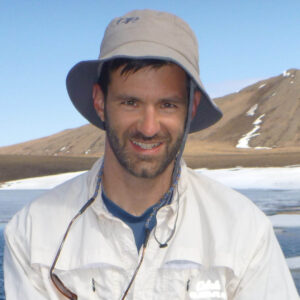
The EcoCode working group aims to synthesize, integrate and advance modelling efforts in support of the GEO-BON mission and to push for an international effort to project biodiversity responses to environmental changes by:
- Synthesizing modelling tools that will inform the Monitoring-to-Mitigation Pathway
- Creating a Coupled Model Intercomparison Project among biodiversity models
- Developing a global, flexible, and adaptable Biodiversity Projection Platform
- Forming a Knowledge-to-Action Hub for co-development of models with stakeholders
- Promoting the uptake of modelling outputs in support of decision making
Monitoring-to-Mitigation Pathway
Flow path moving clockwise from the top (Data observation). At each stage, models play key roles in organizing, estimating, detecting, and projecting biodiversity patterns. The process is cyclical because adaptive management will also include the need for adjusting data observations.

Co-Leads
Mission
To advance the understanding, development, and implementation of biodiversity models to support the GEO BON mission.
Why modelling?
Time is running out to limit further devastating losses of biodiversity and nature’s contributions to humans. Global biodiversity monitoring networks are rapidly improving our ability to observe and understand patterns of biodiversity change worldwide. The next steps toward preventing biodiversity loss require theoretical and conceptual tools that synthesise incoming data, estimate uncertainties, improve data collection, detect trends, attribute trends to drivers, project future changes under differing socioeconomic scenarios and compare results, and design efficient mitigation strategies. In short, modelling is now needed more than ever to translate data into inferences to support decisions for conservation action.
Models are needed at every stage of the Biodiversity Monitoring-to-Mitigation pathway, starting from data observation and continuing through to projection and mitigation:
- Data observation: models are needed that can account for varying sample intensities and methods in order to assess uncertainties accurately.
- Building indicators: models are used to aggregate and differentially weight certain observations into aggregated diversity indicators, especially for use in monitoring trends.
- Trend detection: usually, statistical models that accurately account for propagated errors are applied to evaluate trends of biodiversity change through time.
- Attribution: for attributing biodiversity change to specific drivers, models are required that can represent expected biodiversity patterns with and without focal drivers. These models might take the form of statistical models or mechanistic models parameterized for key processes.
- Projection: biodiversity projections can evaluate the impact of different future social and economic scenarios on future biodiversity – for instance, how different land use and climate change scenarios might affect future biodiversity loss.
- Mitigation: projection models can be used to test mitigation options via simulation and also incorporate additional social costs in prioritising mitigation options.
Why a GEO BON modelling WG?
The models that are now required, ranging from those that account for observation error to those that project future changes in global diversity, are still often less developed and commonly lack standardization, reducing their widespread adoption and application. They further lack integration, often tackling one small aspect of the problem and ignoring other, fundamental, pieces of the puzzle. Therefore, it remains a challenge to pinpoint when, where, and how we need to act to prevent extinctions and ecosystem collapse. International cooperation and organization are necessary to improve not just models but also facilitate their application in the hands of decision makers and practitioners worldwide.
Symposium at GEO BON conference: Advances in Biodiversity Modeling from Monitoring to Mitigation
Discussion at GEO BON conference: What is the best way to predict the future of biodiversity?
Urban MC, Bocedi G, et al. 2016. Improving the forecast for biodiversity under climate change. Science 353, 1113, doi:10.1126/science.aad8466.
Urban MC, Travis JMJ, Zurell D, et al. 2022. Coding for Life: Designing a Platform for Projecting and Protecting Global Biodiversity. Bioscience72, 91-104, doi:10.1093/biosci/biab099. Read online.

 Mark Urban
Mark Urban
 Greta Bocedi
Greta Bocedi
 Damaris Zurell
Damaris Zurell
 Santiago José Elías Velazco
Santiago José Elías Velazco